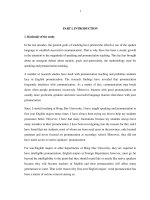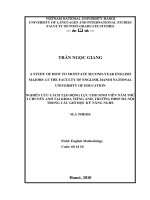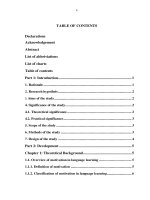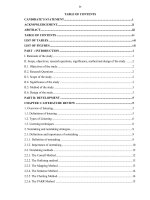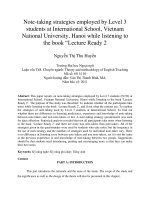Practicing note taking to enhance fourth year english students’consecutive interpretation ability
Bạn đang xem bản rút gọn của tài liệu. Xem và tải ngay bản đầy đủ của tài liệu tại đây (928.79 KB, 89 trang )
CANTHO UNIVERSITY
SCHOOL OF EDUCATION
ENGLISH DEPARTMENT
FINAL PROJECT
PRACTICING NOTE TAKING TO ENHANCE
FOURTH -YEAR ENGLISH STUDENTS’CONSECUTIVE
INTERPRETATION ABILITY
Trung tâm Học liệu ĐH Cần Thơ@Tài liệu học tập và nghiên cứu
SUPERVISOR: NGUYEN BUU HUAN
RESEARCHER: TO MY VIEN
CODE: 7032585
COURSE 29
NN0354A4
CANTHO, JUNE, 2007
Practicing note taking to enhance fourth -year English students’ consecutive interpretation ability
CONTENTS
Content ................................................................................................................... i
Acknowledgement ...............................................................................................iii
Abstract ................................................................................................................ iv
List of Tables and Figures ................................................................................... v
Chapter 1 Introduction
1.1 Problem and Rationale ............................................................................. 1
1.2 Research Question ................................................................................... 2
1.3 Hypothesis ............................................................................................... 3
1.4 Thesis Organization ................................................................................. 4
Chapter
Literature
Review
Trung
tâm2Học
liệu ĐH
Cần Thơ@Tài liệu học tập và nghiên cứu
2.1 Translation ............................................................................................... 6
2.2 Interpretation............................................................................................ 8
2.3 Consecutive Interpretation ..................................................................... 10
2.3.1 Time and setting matter ...................................................................... 10
2.3.2 Short-term Memory ............................................................................ 12
2.3.3 Forgetting Curve ................................................................................. 15
2.4 Note taking in consecutive interpretation .............................................. 16
Chapter 3 Research Methodology
3.1 Participants ............................................................................................ 25
3.2 Instruments ............................................................................................ 26
To My Vien B.A C 29
i
Practicing note taking to enhance fourth -year English students’ consecutive interpretation ability
3.3 Materials ............................................................................................... 27
3.4 Design .................................................................................................... 35
3.5 Procedures.............................................................................................. 37
Chapter 4 Data Analysis
4.1 Analysis of Questionnaires .................................................................... 40
4.2 Analysis of Tests.................................................................................... 44
Chapter 5 Conclusions, Limitations and Recommendations
5.1 Conclusions............................................................................................ 54
5.2 Limitations ............................................................................................. 57
5.3 Recommendations.................................................................................. 60
Trung tâm Học liệu ĐH Cần Thơ@Tài liệu học tập và nghiên cứu
Chapter 6 A suggested system for training note taking in consecutive
interpretation ...................................................................................................... 63
Reference ...................................................................................................... 72
Appendices
Appendix 1 ..............................................................................................................74
Appendix 2 ..............................................................................................................75
Appendix 3 ..............................................................................................................................76
Appendix 4 ............................................................................................................... 77
Appendix 5 ............................................................................................................... 79
Appendix 6 ............................................................................................................... 80
To My Vien B.A C 29
ii
Practicing note taking to enhance fourth -year English students’ consecutive interpretation ability
ACKNOWLEDGEMENT
Firstly, I would like to express my gratitude to Mr. Nguyen Buu Huan, my
supervisor for his great and continued generous support and useful advice.
Special thanks are also given to Ms Truong Thi Ngoc Diep and Ms Nguyen
Thi Bich Thuy, who were very eager to help me collect my useful data.
In particular, sincere thanks go to Mr. Trinh Quoc Lap for providing me with
constructive comments in refining my thesis.
I, from the bottom of my heart, wish to thank my parents who bring me up
with their interest and caring and my teachers in English Department who raise me
up with their knowledge. Thanks for all, I have occasion to do the project, to
Trung
tâm Học
liệuhow
ĐH
Cầnchallenges
Thơ@Tài
học
tập invàlife.
nghiên cứu
investigate,
to know
to face
and toliệu
be more
mature
Finally, in completing my research paper, I owe a debt of gratitude to all of
my friends. I thank them for spending their time doing questionnaires and tests.
Especially, I would like to thank Ms Le Thi Kim Phung and Ms Huynh Do Thu for
their energy and encouragement.
Although some syntactical or linguistic faults may appear in my study, I am
solely responsible for all.
To My Vien B.A C 29
iii
Practicing note taking to enhance fourth -year English students’ consecutive interpretation ability
ABSTRACT
The purpose of this study was to investigate the effectiveness of note taking
in consecutive interpretation. In detail, I want to measure whether note taking
helps student recall information or distract them from concentrating ability.
Questionnaires were first delivered to the fourth-year students of English to
consider their perception toward note taking in consecutive interpretation.
Importantly, thanks to using interview with five questions I could get a deeper
understanding about students’ attitude on this problem.
The results collected from questionnaires and interview told me most of
students believe that note taking plays an important role when interpreting
Trung
tâm HọcAlso,
liệuthey
ĐHmay
Cần
Thơ@Tài
liệu
học
consecutively.
be distracted
in cases
what
theytập
havevà
to nghiên
interpret iscứu
rather complicated.
The two tests were implemented by 40 students to reliably check the
efficiency of note taking. It is possible to conclude that the simplicity or
complexity of materials and marking scales had a great influence on the
effectiveness of note taking. Considerably, note taking maintains its usefulness
regardless of the great different standards between the two tests.
Some limitations and recommendations were also given for better studies
about note–taking in consecutive interpretation.
To My Vien B.A C 29
iv
Practicing note taking to enhance fourth -year English students’ consecutive interpretation ability
List of figures and tables
Table 1 Frequency of questionnaires .................................................................. 42
Table 2 Marking paper ........................................................................................ 45
Table 3 Scores of interpretation in the second test .............................................. 49
Figure 1 Model of general translating process ..................................................... 12
Figure 2 Case processing summary ..................................................................... 40
Figure 3 Percentage of questionnaires on the third item...................................... 43
Figure
4 Percentage
questionnaires
on the fifth item
44 cứu
Trung
tâm
Học liệuof ĐH
Cần Thơ@Tài
liệu......................................
học tập và nghiên
Figure 5 The disparity of the first test in class 03 ............................................... 46
Figure 6 The disparity of the first test in class 04 ................................................ 46
Figure 7 Marks of accuracy in the second test ..................................................... 50
Figure 8 Marks of clarity in the second test ......................................................... 51
Figure 9 Marks of fluency in the second test ....................................................... 51
Figure 10 Marks of eye-contact in the second test .............................................. 52
Figure 11 Marks of self-confidence in the second test ........................................ 52
To My Vien B.A C 29
v
Practicing note taking to enhance fourth -year English students’ consecutive interpretation ability
Trung tâm Học liệu ĐH Cần Thơ@Tài liệu học tập và nghiên cứu
To My Vien B.A C 29
vi
Practicing note taking to enhance fourth-year English students‘ consecutive interpretation ability
CHAPTER 1
INTRODUCTION
1.1 Problem and Rationale
As it is widely held that interpretation skill is quite crucial to letter students of
English, in comparison with four-language skills-listening, speaking, reading and
writing-interpreting is, however, not paid much attention to. For the matter, they find
it hard and nervous in interpretation class in the short term. If they, in the long run,
choose interpreters as their desired careers, they will confront with a great number of
difficulties due to lack of trained skills necessary for interpretation. I am, in my study,
mentioning note taking skill.
Not surprisingly, without taking any notes, interpreters cannot remember
Trung
tâm Học
ĐH Cần
liệu học tập
nghiên
cứu
information
fullyliệu
and exactly
whenThơ@Tài
interpreting consecutively.
Thevà
point
here is that
they may be prevented from listening if they have no experiences of note taking. This
is the reason why I choose practicing note taking to improve fourth-year English
students‘ consecutive interpretation ability as my confidential topic. I think I can find
out best solutions that help students train note taking as an important skill for their job
later.
To My Vien B.A C 29
1
Practicing note taking to enhance fourth-year English students‘ consecutive interpretation ability
1.2 Research Question
We, of course, cannot deny the effectiveness of note taking in consecutive
interpretation. It means, due to limits of short –term memory, we cannot remember
fully what the speaker speaks. Or, interpreters are required a fast speed of interpreting;
therefore, they are under pressure of both time and setting. Unfortunately, to
inexperienced interpreters or student interpreters, taking notes while interpreting, to
some extent, may cause many problems. That is to say, it may distract them from their
concentrating ability with note taking.
This is why I in my research try to answer the only following question:
―Does note taking in consecutive interpretation help fourth-year English
students recall information or distract them from concentrating?‖
Trung tâm Học liệu ĐH Cần Thơ@Tài liệu học tập và nghiên cứu
To My Vien B.A C 29
2
Practicing note taking to enhance fourth-year English students‘ consecutive interpretation ability
1.3 Hypothesis
In consecutive interpretation, interpreters have to interpret a complete thought of
the speaker. There is certainly a lot of information to remember. Thus, with note
taking, they can interpret better since they can, hypothetically recall exactly the
speaker‘s talk.
Trung tâm Học liệu ĐH Cần Thơ@Tài liệu học tập và nghiên cứu
To My Vien B.A C 29
3
Practicing note taking to enhance fourth-year English students‘ consecutive interpretation ability
1.4 Thesis Organization
Chapter 1 Introduction
Why do I choose this topic as my confidential one? What I want to measure
when carrying out the topic? Particularly, the readers can find out answers for these
questions in the first chapter of the thesis – Introduction.
Literature Review
Some works closely related to my study are clearly stated in this part of the
thesis. Basically, the literature review gave me a strong and stable foundation to
implement my own topic.
Chapter 3 Research Methodology
Purposefully, the chapter outlines the ways I precede the study including the
approach of choosing participants, the selecting of instruments and the methods of
Trung
tâm Học liệu ĐH Cần Thơ@Tài liệu học tập và nghiên cứu
designing the research.
Chapter 4 Data Analysis
In this selection, basing on data collected and analyzed from questionnaires and
the two tests, the readers, themselves can withdraw their own point of view about my
previously mentioned problem.
Chapter 5 Conclusions, Limitations and Recommendations
That note taking is really effective to the fourth-year English students and that
there are still some unavoidable shortcomings in the thesis are all mentioned in the
final chapter. Also, thanks to discovering many interesting and useful issues when
To My Vien B.A C 29
4
Practicing note taking to enhance fourth-year English students‘ consecutive interpretation ability
doing the study, I have some recommendations for better researches on note taking in
consecutive interpretation.
Trung tâm Học liệu ĐH Cần Thơ@Tài liệu học tập và nghiên cứu
To My Vien B.A C 29
5
Practicing note taking to enhance fourth-year English students‘ consecutive interpretation ability
CHAPTER 2
LITERATURE REVIEW
I. Translation
1. Definition of translation
Within a communicative framework of translation, we must start from the
assumption that translation is a combination of two consecutive operations: a source
text-analytical operation and a target language text-synthetically or text-reproductive
operation.
(Wills 1982b:4)
The above paragraph must be a very good beginning of the research since it
gives a general viewpoint of translation. Necessarily, I will state some definitions
about translation, oral translation or
interpretation, especially consecutive
interpretation.
Trung
tâm Học liệu ĐH Cần Thơ@Tài liệu học tập và nghiên cứu
Throughout history, written and spoken translation have played a crucial role in
inter-human communication, not least in providing access to important texts for
scholarship and religious purposes. Yet the study of translation as an academic subject
has only really begun in the past fifty years (Mundey, Jeremy, 2001:5). According to
Nida and Taber (1974:12) translation consists in reproducing in the receptor language
the closest natural equivalent of the source language message, first in terms of
meaning and secondary in terms of style.
Or, translation is the expression in another language (or target language) of what
has been expressed in another (source language), preserving semantic and stylistic
equivalencies (Dubois 1973, cited in Bell 1991:5). Besides, translating is the
To My Vien B.A C 29
6
Practicing note taking to enhance fourth-year English students‘ consecutive interpretation ability
transformation of a text originally in one language into an equivalent text in a
different language retaining, as far as possible, the content of the message, and the
formal features and the role of original text (Bell 1991: XIII). In addition, translation
is a communicative process, which takes place within a social context (Hatim and
Mason 1990:3). Considerably, translation is defined in different ways according to
different people. Therefore, ―what is translation?‖ is still a question in need of
research (Van, Hoang Van, 1995:9).
2. Kinds of translation.
There are two forms of translation: written translation and oral translation or
interpretation. Basically, the two forms are similar to each other on the aims and the
reasoning (Yen, Nguyen Thanh, 2005: 363). However, the differences between the
two must, of course, be taken into consideration. ―While it is possible for one person
Trung
tâm Học liệu ĐH Cần Thơ@Tài liệu học tập và nghiên cứu
to work both as a translator and an interpreter, the skills required for the two activities
vary considerably‖ (Cay Dollerup and Anne Loddegaard, 1992:173). In spite of the
similarity, the required skills of translation and interpretation are totally different.
Also, the writers mentioned that ―translations can be drafted, revised, criticized
and edited before publication‖ say Glickman in Brian Harris‘s article, but: ―the
interpreter must get his version right first time: there is no editor to act as a filter
between him and his listener‖ (1992:199). The great differences tell us interpreters
must face pressure of time. Particularly, the speed of interpreting is 30 times faster
than that of translating (Yen, Nguyen Thanh, 2005: 363).
To My Vien B.A C 29
7
Practicing note taking to enhance fourth-year English students‘ consecutive interpretation ability
Besides, the differences between translation and interpretation may be due as
much to the respective semiotic statuses of text and spoken utterances as to practical
working conditions. A text has a certain semiotic status in our culture which renders
in sacrosanct (Brian Harris, 1981:156). As stated, translation uses written language
while interpretation uses spoken language. When mentioning translation, many people
may think of only written translation and forget the importance of interpretation (Yen,
Nguyen Thanh. 2005: 12). Actually, interpretation is more difficult than translation
and used widely.
II. Oral translation or Interpretation
1. Definition of interpretation
About interpretation, as Daniel Gile points out, the process of interpreting
depends on a delicate of attention sharing between listening and analyzing,
Trung
tâm Học liệu ĐH Cần Thơ@Tài liệu học tập và nghiên cứu
memorization and reformulation (1988:7). A process including both listening,
analyzing, memorization and reformulation at the same time is not easy at all.
Therefore, student interpreters must be trained with some important skills that support
them. According to Inglis (1984:2) the interpreter is often involved in immediate
interaction with one or other speaker, functioning as himself, asking for clarification,
explanation, repetition, etc.
Interpretation is the process establishing, either simultaneously (known as
simultaneous interpretation) or consecutively (known as consecutive interpretation),
oral communication or gestures between two or more speakers who are not able to use
the same set of symbols (Wikipedia, the free encyclopedia. 2007). Mahmoodzadeh
To My Vien B.A C 29
8
Practicing note taking to enhance fourth-year English students‘ consecutive interpretation ability
(1992:231) gives a more detailed definition of interpreting: Interpreting consists of the
presenting in the target language, the exact meaning of what is uttered in the source
language either simultaneously or consecutively, preserving the stone of the speaker.
2. Two forms of interpretation
The two main kinds of interpretation are, as mentioned previously,
consecutive
interpretation
and
simultaneous
interpretation.
Simultaneous
interpretation is a highly specialized area of translations, which requires accurate and
complete translation, orally and at the same rate of speech as the speaker, with only a
few seconds of lag time (Barinas Translation Consultants, Inc, 1985).
However, in my research, I just focus on consecutive interpretation. In its
purest form, consecutive interpretation is a mode in which the interpreter begins their
interpretation of a complete message after the speaker has stopped producing the
Trung
tâm Học liệu ĐH Cần Thơ@Tài liệu học tập và nghiên cứu
source utterance (Santiago, Roberto, 2004). ―Consecutive oral interpretation is the
translation of a speaker with the necessary pauses needed for the translator to replay
the translation. The pauses are small as a rule. During speech, the translator already
begins to technically form the translation and during the pause, completes it‖ (Tran
slink, 2007).
During consecutive interpreting the speaker stops every 1-5 minutes (usually
at the end of every ―paragraph‖ or complete thought) and the interpreter then steps in
to render what was said into the target language. A key skill involved in consecutive
interpreting is note taking, since few people can memorize a full paragraph in one
hearing without loss of detail (RIC International, 2007). ―Consecutive interpretation
To My Vien B.A C 29
9
Practicing note taking to enhance fourth-year English students‘ consecutive interpretation ability
requires the interpreter to convey the full and accurate meaning of speech from the
source language into the target language after the speaker had concluded speaking.
Depending on the setting, the speaker may pause periodically to allow for
interpreting to take place or continue until the full speech has been delivered.
Interpreters generally take notes as memory aids to reconstruct the message and seek
clarification if the request will not disrupt the event‖ (). Both
consecutive and simultaneous interpretation is similar to each other in the essential
skills. That is, the interpreters are able to ―grasp the points and arguments that a
speaker is presenting after hearing them once, and to reproduce them clearly and
immediately.‖
However, ―the difference between consecutive and simultaneous interpretation
is to be found in the nature of the ―immediacy‖ required: in consecutive interpretation
Trung
tâm Học liệu ĐH Cần Thơ@Tài liệu học tập và nghiên cứu
interpreters take notes during a speaker‘s contribution and give the interpretation
immediately afterwards, while in simultaneous interpretation they interpret while the
speaker is still taking, listening to what they are saying now while saying what has
just been said‖ (Don Jaime, 2007).
III. Consecutive Interpretation
1. Time and setting matter
In consecutive interpretation, time and space matters must be paid great
attention to by any interpreter. Time is a completely important element in this kind of
interpretation. When the speaker finishes his talk, the interpreter interprets
To My Vien B.A C 29
10
Practicing note taking to enhance fourth-year English students‘ consecutive interpretation ability
immediately without time to choose beautiful words. Asking ―pardon me‖ is the only
way if there is some unknown words (Yen, Nguyen Thanh, 2005: 12).
For the matter, translators have to develop time management skills to assess
their working capacity, in particular if they work on a free-lance basis, but it is never
as pressing as for interpreters, where time is definitely a limiting factor (Cay Dollerup
and Anne Loddegaard, 1991:174).
It is clearly stated that interpreters may face the pressure of time when
interpreting. They are required to interpret as quickly as possible during the pauses.
Also, the two writers said that ―time and space constraints in interpreting require a
great deal of flexibility and versatility on the part of the interpreter.‖ In addition, in
some important international conferences, the setting may be a pressure to
interpreters. They may, for example, decide the fate of the whole country. To solve
Trung
tâm Học liệu ĐH Cần Thơ@Tài liệu học tập và nghiên cứu
the problem, interpreters must be trained with a special skill that helps them interpret
accuracy and fluency. This skill is mentioned below.
To My Vien B.A C 29
11
Practicing note taking to enhance fourth-year English students‘ consecutive interpretation ability
2. Short-term memory
Figure 1
Model of general translating process (Hung, Nguyen Thuong, 2005:14)
MEMORY
ANALYSIS
Source Language
Text
Meaning
Description
Trung tâm Học liệu ĐH Cần Thơ@Tài liệu học tập và nghiên cứu
SYNTHESIZE
Target
Language Text
I purposefully give the model to tell the importance and the necessity of
memory in interpretation in particular. Whether the three steps of analyzing, meaning
description and synthesizing can be carried out fluently and exactly mostly depends
on the first stage – memory. Understandably, memory has a great influence on the
To My Vien B.A C 29
12
Practicing note taking to enhance fourth-year English students‘ consecutive interpretation ability
effectiveness of interpretation. Therefore, I in this part of the research will state some
literatures related to memory in consecutive interpretation.
An excellent interpreter must be, of course, knowledgeable in both source
language and target language. He or she is required to have ―strong educational
background and extensive training‖ (English Russian Translation, 2007). The point is
what would happen if the interpreter has no short-term memory.
As mentioned, ―the human brain has evolved to encode and interpret complex
stimuli- images, color, structure, sounds, smell, tastes, touch, spatial awareness,
emotion, and language using them to make sophisticated interpretations of the
environment. Human memory is made up of all these features‖ (Zhong, Weihe, 2003).
It is stated by psychological studies that there is a distinction between short-term
memory and long-term memory.
Trung
tâm Học liệu ĐH Cần Thơ@Tài liệu học tập và nghiên cứu
Short-term memory is the one that interpreters need to be trained carefully
and effectively and that I focus most in this part, not long-term memory. Smith
(1985, 38) notes that, ―Short term memory has a very limited duration. We can
remember six or seven items only as long as we give all of our attention to them‖.
―The idea of short-term memory simply means that you are retaining information for
a short period of time without creating the neutral mechanisms for later recall.‖ The
duration of short-term memory is very short. It is up to 30 seconds, Peterson (1959)
found it to be 6-12 seconds while Atkinson and Shiffrin (1968) and Hebb (1949) state
it is 30 seconds.
To My Vien B.A C 29
13
Practicing note taking to enhance fourth-year English students‘ consecutive interpretation ability
Considerably, in consecutive interpretation, it requires ―a speaker
to pause
every few sentence to allow the interpreter to interpret what has just been said‖(
English
Russian Translation, 2007). And in consecutive interpreting, there is
probably up to 15 minutes (depending on the speaker‘s segments) for the interpreter
to encode and then store the information (the first phase of Gile‘s effort Model for
consecutive interpretation).
In this case, we cannot deny the importance of short-term memory. It is a
helpful and essential component of any interpreter. This is the reason why in the
article Memory Training in Interpreting (Weihe Zhong, 2003) and in Introduction to
Consecutive Chapter (from the Interpreter‘s Edge, third Edition), the writers mention
a lot about the significance of short- term memory, its training and exercises. They
are closely related to my research topic; therefore I will review them very careful. To
Trung
tâm Học liệu ĐH Cần Thơ@Tài liệu học tập và nghiên cứu
answer the question: ―Why is memory training?‖ It is first given some definitions of
interpreting. According to Shuttle worth and Cowie (1997:83), interpreting is defined
as ―oral translation of a written text.‖ Interpreting consists of presenting in the target
language, the exact meaning of what is uttered in the source language either
simultaneously or consecutively, preserving the tone of the speaker (1992:231).
One of the required qualifications for an interpreter, according to Phielan, is that
―the interpreter needs a good short-term memory to retain what he or she has just
heard‖. Likely, Kambiz Mahmoodzadeh also emphasizes that a skillful interpreter is
expected to have a powerful memory (1992:233). Besides, ―it is rare for a person to
To My Vien B.A C 29
14
Practicing note taking to enhance fourth-year English students‘ consecutive interpretation ability
use short and simple statements when speaking; therefore, an interpreter must first
and foremost have a powerful memory.‖
Again, the importance of short-term memory must be admitted in consecutive
interpretation. Note, however, the capacity of short-term memory is limited and small.
It, thus leads to the phenomenon of information loss. And, there are three main
theories as to why we forget our short-term memory. Displacement- existing
information is replaced by newly received information when the storage capacity is
full (Waugh and Norman, 1965). Next, Decay- information decays over time
(Baddeley, Thompson and Buchanan, 1975). The final theory is interference- other
information present in the storage at the same time distorts the original information
(Keppel and Underwood, 1962). In addition, ―a consecutive interpreter listens to a
speech and the produces it in a different language. This means that he or she must
Trung
tâm Học liệu ĐH Cần Thơ@Tài liệu học tập và nghiên cứu
resort to short –term memory. For this reason, mnemonic techniques are of paramount
importance in interpreter‘s training‖ (Guía Metodológica, Traducción IV, 2007)
2. Forgetting Curve
The problem is that even though an interpreter is really talented, he or she
may face many difficulties due to the loss of information coming from short-term
memory. Clearly, Rob Waring (2002), Notre Dame Seishin University Okayama, said
that ―It is easier to forget a word than remember it. Initial word knowledge is very
fragile and memories of new words that are not met again soon are lost. This is
because our brains are designed to forget, not to remember.‖ It, therefore leads to a
situation called ―forgetting curve‖. Together with the pressure of time, setting, limit of
To My Vien B.A C 29
15
Practicing note taking to enhance fourth-year English students‘ consecutive interpretation ability
memory is unavoidable. ―The forgetting curve illustrates the decline of memory
retention in time.‖ (From Wikipedia, the free encyclopedia, 2007). Also, a related
concept is the strength of memory that refers to the durability that memory traces in
the brain. The better memory, the longer we can remember it.
IV. Note taking in consecutive interpretation
Considerably, due to the limit of short-term memory, the forgetting curve, the
pressure of time, and many others, interpreters are prevented from getting accuracy
and fluency in interpretation. We need an effective skill that helps them overcome this
matter. What is the skill? The answer will be shown clearly thanks to the formula of
Daniel Gile.
According to him, consecutive interpreting consists of two phases: a listening
and reformulation phase and reconstruction phase (Gile, 1992:191,1995b:179)
Trung
tâm Học liệu ĐH Cần Thơ@Tài liệu học tập và nghiên cứu
Phase one: I = L + M + N
I = Interpreting
L = Listening and analyzing the source language speech.
M = Short-term memory required between the time information is heard and the
time it is written down in the notes.
N = Note taking
To answer the question above, ―N‖ in the formula is the best answer. That is
note taking. It is the most important focus in my research. I, thus provide some related
works of note taking.
To My Vien B.A C 29
16
Practicing note taking to enhance fourth-year English students‘ consecutive interpretation ability
―Taking notes while interpreting is notoriously difficult yet essential.‖ You may
well interpret 2 sentences from memory, even 3 or 4 if you have your wits about you.
But coming the fifth sentence you will have forgotten the first and the second. Your
brain is constantly working overtime, leaving you with just a faint idea of what it was
all about. That is why a notebook and a pen are an interpreter‘s best friends, but they
only help if your note taking system is already properly established‖ (Jean –Francois
Rozan, 2005).
We cannot, of course remember so many sentences during interpreting;
therefore, note taking is really necessary to an interpreter. According to Kiewra and
Frank (1985) note taking research, along with educational research is general, has
begun to concentrate on the cognitive processes of individual learners. Not
surprisingly, each individual learner has his or her own awareness of note taking as
Trung
tâm Học liệu ĐH Cần Thơ@Tài liệu học tập và nghiên cứu
well as its importance. That is, note taking must be researched basing on students‘
cognitive processes for good result.
―Note- taking is and essential element of consecutive interpreting. It consists of
noting on paper the logic and structure of a speech in order to help the interpreters
remember the contents of the speech‖ (AIIC‘s Conference Interpretation Glossary,
1998). ―When the interpreter has his notes in front of him, he will enhance the quality
of his job to a high degree and he will produce a better rendition. Without taking
notes all the interpreters‘ attention will be focused on trying to remember what has
actually been said, which usually leads to poor interpretations.‖
To My Vien B.A C 29
17
Practicing note taking to enhance fourth-year English students‘ consecutive interpretation ability
Because ―for consecutive interpretation, the interpreter is required to listen to a
consecutive speech for five to ten minutes and then expresses all the contents in
another language accurately and eloquently‖ (Rupert Ye, 2003-2005), because it is
almost impossible for them to recall all the element of the speech, because
interpreters will be under pressure of many factors, because they play a paramount
role in communication, they have to take notes, of course. For the matter, considering
that effective note taking is one of the major prerequisites for quality interpretation,
the nuance of note taking skills should then be regarded as a separate skill to be
trained and developed through out the interpretation curriculum (Lung, Rachel, 1999).
According to Jonathan (United States, 2007), ―most conference interpreters have a
system of note takings consecutive speeches that includes noting down the ―skeleton‖
of the speech, and the numbers, names, lists and other features ones is likely to
Trung
tâm Học liệu ĐH Cần Thơ@Tài liệu học tập và nghiên cứu
forget.‖
Also, in the article ―Models of Interpreting‖ (RIC International, Inc.), ―during
consecutive interpreting the speaker stops every 1-5 minutes (usually at the end of
every ―paragraph‖ or complete thought‖ and the interpreter then steps in to render
what was said into the target language. A key skill involved in consecutive
interpreting is note taking since few people can memorize a full paragraph in one
hearing without loss of detail.‖
As mentioned above, interpreters are unable to remember all the element of a
rather long speech, so note takings help them recall these elements. ―The interpreter,
at first, has to make out what the speaker means in source language. Then, to code the
To My Vien B.A C 29
18




